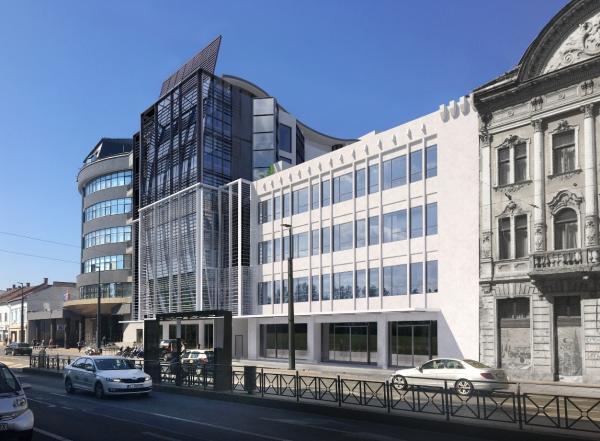EUR 809 million EIB Group support for COVID-19 resilience, education, water, energy efficiency and private investment in Romania

- EIB and EIF working with leading Romanian banks to strengthen COVID-19 economic resilience
- EIB streamlined university investment scheme already backing investment at Cluj Technical University and Bucharest Medical University
- Record disbursement for Romanian projects and strong pipeline of future hospital, education, road safety and water financing
Higher education, water distribution, energy efficiency and private sector investment across Romania will benefit from more than EUR 809 million of new financing from the European Investment Bank and European Investment Fund agreed with Romanian public and private partners last year.
The European Investment Bank Group’s engagement also included targeted financing to ensure that Romanian companies can continue to invest and better face business challenges caused by the COVID-19 pandemic.
“The coronavirus pandemic made 2020 a uniquely challenging year for Romania, Europe and the whole world. The European Investment Bank Group has made a crucial contribution to helping businesses across Romania better withstand the economic challenges of COVID-19 and enabling priority higher education, health, water and energy investment to accelerate. The close cooperation between the EIB Group and Romania has transformed economic opportunities, priority infrastructure and key services in our country. The strong pipeline of future EIB and EIF engagement in Romania will build on this impressive track record.” said Alexandru Nazare, Romanian Finance Minister and Governor of the European Investment Bank.
“Ensuring that companies continue to invest and priority projects can proceed is crucial to reduce the impact of COVID-19 and build a better future. The excellent collaboration between Romanian public and private partners and colleagues from the European Investment Bank Group, including our technical and financial experts in Bucharest, have once again delivered transformational support for economic, social and climate investment in Romania. The EUR 809 million new EIB and EIF financing agreed in 2020 will benefit thousands of companies, students and households across the country in the years ahead.” said Christian Kettel Thomsen, EIB Vice President responsible for Romania.
“In 2020 the EIF provided more than EUR 387 million of new financing for small businesses across Romania. This included new guarantee and equity transactions, support for ten local microfinance schemes and backing for a first-of-its-kind synthetic securitisation transaction in Romania, to scale up leasing finance. The EIF teams in Bucharest and Luxembourg remain committed to working with our Romanian partners to continue mobilising high-impact private investment in Romania.” said Alain Godard, Chief Executive of the European Investment Fund.
Details of the EIB Group’s highly important financial and technical support for long-term and priority investment were outlined earlier today by Christian Kettel Thomsen, EIB Vice President responsible for Romania, Alain Godard, Chief Executive of the European Investment Fund and Debora Revoltella, EIB Chief Economist.
EIB and EIF backing for priority investment discussed with Ministers
Confirmation of the reinforced EIB Group engagement in Romania follows meetings over recent weeks with Alexandru Nazare, Romanian Finance Minister and Governor of the European Investment Bank, and Ministers responsible for Investments and European Projects, Energy and Transport.
Strengthening private sector investment and COVID-19 economic resilience
Business investment, leasing by agriculture, manufacturing and service companies and ensuring more inclusive access to finance across Romania will be enhanced by EUR 633 million of new private sector support agreed between the EIB, EIF and leading Romanian financial partners.
This includes more flexible and increased financing for business investment, provided through local banks and financial institutions, to ensure that Romanian companies can better withstand business pressures and economic challenges resulting from the COVID-19 pandemic.
New EIB support for private sector investment in Romania also included EUR 100 million backing to expand warehouse and supply chain capacity across the country and new lending programmes to ensure that entrepreneurs and socially disadvantages communities can access finance.
The EIB and EIF also backed the first ever synthetic securitisation deal in Romania that will strengthen specialist leasing finance and enable Romanian companies to upgrade manufacturing equipment and transport fleets.
New report shows mixed impact of COVID-19 on business investment in Romania
New EIB economic research suggests that business in Romania has became more pessimistic about the short-term outlook, very similar to peers across the EU. Pessimism is greatest about the economic climate.
The European Investment Bank Investment Survey highlights that uncertainty about the future remains the most cited long-term barrier to investment (82%), followed by the limited availability of skilled staff (72%). Firms in Romania are more likely than EU peers to cite adequate transport infrastructure as a long-term barrier to investment (63% versus 40%).
The new investment survey indicated that business investment is focused on replacement of existing buildings and production equipment and tilted towards tangibles. Around a quarter (27%) of firms in Romania report abandoning or delaying investment plans as a result of COVID-19, fewer than the EU average (35%).
The same proportion of firms in Romania (27%) also report continuing with investment plans albeit on a reduced scale or scope, i.e. well above the EU average (18%). Around one in ten firms face finance constraints, and reliance on internal financing sources remains high. Access to finance is more of an issue in Romania than in other EU countries and firms lagging with investments in digitalisation and energy efficiency face greater difficulties in successfully tapping external financing.
About Romania’s green transition potential, three-quarters of Romanian businesses (75%) say that climate change currently has an impact on their business, well above the EU average (58%) while, two-thirds of firms (66%) report already investing or planning to invest in climate related projects, in line with the EU average (67%). However, only 37% of firms managed to invest in measures to improve energy efficiency, well below the EU average (47%).
Accelerating investment to transform higher education in Romania
Last summer the EIB launched its first streamlined higher education financing scheme in Romania. This will help to improve teaching, research and innovation at institutions across the country for the period 2021-2025.
The first two loans have been agreed with the Technical University of Cluj-Napoca and the University of Medicine and Pharmacy “Carol Davila” Bucharest. These will help to accelerate strategic development, enhance research facilities and strengthen education to benefit students and researchers in the years ahead.
The EIB is in discussions with other higher education institutions across Romania to support further investment and allow university investment to benefit from long-term financing and the EIB’s unique technical experience supporting education investment across Europe.
Cutting heating costs in homes and schools
Last year the EIB continued its track record of supporting energy efficiency in Romania and agreed EUR 42 million of new financing toward the Energy Efficiency Investment Programmes of three districts in Bucharest.
In their entirety, the programmes aim to reduce energy use and cut heating bills for 900 residential buildings and 19 schools, and EIB’s fresh funding supports the implementation progress. This new support will assist implementation of Romania’s National Energy Efficiency Action Plan and the EU Resource Efficiency Initiative.
Strong pipeline for future EIB and EIF engagement in Romania
In the coming months new EIB expects to finalise support for construction of three new hospitals, a Regional Emergency Hospital in Iasi and new regional hospitals in Craiova and Cluj.
New schemes to improve road safety across the country, long-term financing to expand and update regional water infrastructure, following support last year for water schemes in Cluj-Salaj, and new initiatives to support business financing and municipal investment are also foreseen.
Building on track record of EIB Group engagement in Romania
Since 1991 the EIB and EIF have provided more than EUR 17 billion for transformational private and public investment across Romania.



